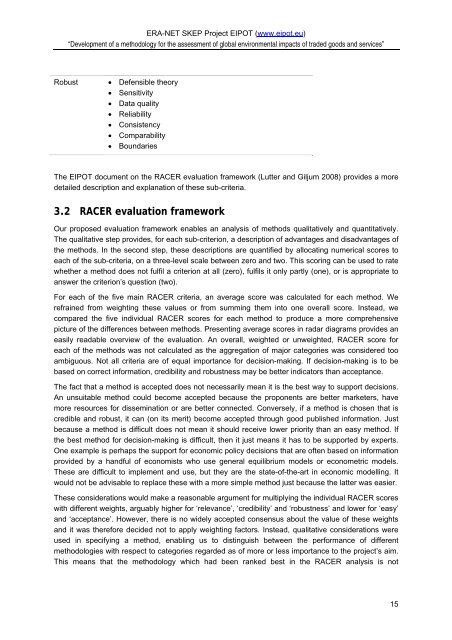EIPOT Final Project Report - Stockholm Environment Institute
EIPOT Final Project Report - Stockholm Environment Institute
EIPOT Final Project Report - Stockholm Environment Institute
You also want an ePaper? Increase the reach of your titles
YUMPU automatically turns print PDFs into web optimized ePapers that Google loves.
ERA-NET SKEP <strong>Project</strong> <strong>EIPOT</strong> (www.eipot.eu)<br />
“Development of a methodology for the assessment of global environmental impacts of traded goods and services”<br />
Robust<br />
• Defensible theory<br />
• Sensitivity<br />
• Data quality<br />
• Reliability<br />
• Consistency<br />
• Comparability<br />
• Boundaries<br />
The <strong>EIPOT</strong> document on the RACER evaluation framework (Lutter and Giljum 2008) provides a more<br />
detailed description and explanation of these sub-criteria.<br />
3.2 RACER evaluation framework<br />
Our proposed evaluation framework enables an analysis of methods qualitatively and quantitatively.<br />
The qualitative step provides, for each sub-criterion, a description of advantages and disadvantages of<br />
the methods. In the second step, these descriptions are quantified by allocating numerical scores to<br />
each of the sub-criteria, on a three-level scale between zero and two. This scoring can be used to rate<br />
whether a method does not fulfil a criterion at all (zero), fulfils it only partly (one), or is appropriate to<br />
answer the criterion’s question (two).<br />
For each of the five main RACER criteria, an average score was calculated for each method. We<br />
refrained from weighting these values or from summing them into one overall score. Instead, we<br />
compared the five individual RACER scores for each method to produce a more comprehensive<br />
picture of the differences between methods. Presenting average scores in radar diagrams provides an<br />
easily readable overview of the evaluation. An overall, weighted or unweighted, RACER score for<br />
each of the methods was not calculated as the aggregation of major categories was considered too<br />
ambiguous. Not all criteria are of equal importance for decision-making. If decision-making is to be<br />
based on correct information, credibility and robustness may be better indicators than acceptance.<br />
The fact that a method is accepted does not necessarily mean it is the best way to support decisions.<br />
An unsuitable method could become accepted because the proponents are better marketers, have<br />
more resources for dissemination or are better connected. Conversely, if a method is chosen that is<br />
credible and robust, it can (on its merit) become accepted through good published information. Just<br />
because a method is difficult does not mean it should receive lower priority than an easy method. If<br />
the best method for decision-making is difficult, then it just means it has to be supported by experts.<br />
One example is perhaps the support for economic policy decisions that are often based on information<br />
provided by a handful of economists who use general equilibrium models or econometric models.<br />
These are difficult to implement and use, but they are the state-of-the-art in economic modelling. It<br />
would not be advisable to replace these with a more simple method just because the latter was easier.<br />
These considerations would make a reasonable argument for multiplying the individual RACER scores<br />
with different weights, arguably higher for ‘relevance’, ‘credibility’ and ‘robustness’ and lower for ‘easy’<br />
and ‘acceptance’. However, there is no widely accepted consensus about the value of these weights<br />
and it was therefore decided not to apply weighting factors. Instead, qualitative considerations were<br />
used in specifying a method, enabling us to distinguish between the performance of different<br />
methodologies with respect to categories regarded as of more or less importance to the project’s aim.<br />
This means that the methodology which had been ranked best in the RACER analysis is not<br />
15
















